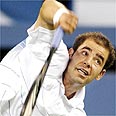Whipping action comes in the kinetic chain when one element abruptly stops, transferring speed to the next element. To get the maximun whipping action on the serve, aim the arm up at ball, as it causes the wrist and racket to get maximum velocity. As the arm slows down, the wrist whips forward, when the wrist slows down at impact, the weight of the racquet is then forced downward.
If you aim forward, you are shifting your maximum to a point after impact and end up muscling the ball at impact, instead of whipping it. Instead you should aim up at the ball. An indication that this has been done correctly is therefore the racket head pointing downwards after impact. (the pronation is automatic)
Please let me know if this reasoning is correct John. Thanks!
If you aim forward, you are shifting your maximum to a point after impact and end up muscling the ball at impact, instead of whipping it. Instead you should aim up at the ball. An indication that this has been done correctly is therefore the racket head pointing downwards after impact. (the pronation is automatic)
Please let me know if this reasoning is correct John. Thanks!




Comment